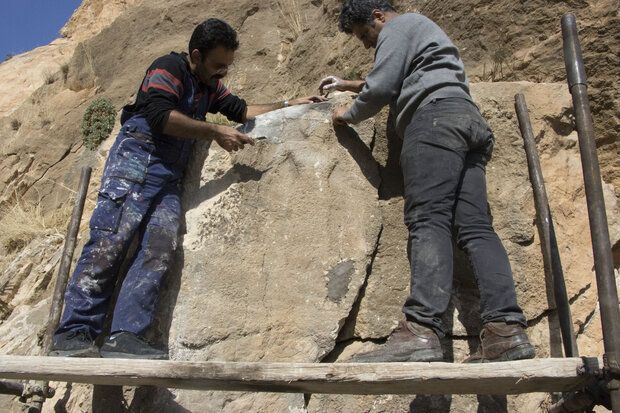Ancient Iranian relief depicting victory over enemies restored

TEHRAN – A team of Iranian archaeologists and restorers have completed an intricate restoration project on a 3rd-millennium-BC bas-relief, which depicts the victory of a King over his enemies. The relief is carved on the face of a rock cliff in Salas-e Babajani county, Kermanshah province.
“A bas-relief [located] in Salas-e Babajani, which was once determining a political border between Iran and Mesopotamian, has been fully restored by experts affiliated with Iran’s Research Institute for Cultural Heritage and Tourism,” Mehr reported on Tuesday.
The relief shows a scene of a king’s victory over his enemies, in which the king's body is larger than the others, with one of his legs placed on a captive's abdomen, the report said.
The work of art had been suffered from triple problems; an earthquake with a moment magnitude of 7.3 that occurred on the Iran–Iraq border in November 2017; heavy downpours; and vandalize acts.
To restore the relief, some epoxy resins were merged with mineral supplements to come close to the original color of the object but attempted to make a slight difference so that forthcoming generations would not have trouble for conducting further research. For areas with deep fracture points, stainless steel wires were used and molded with specific epoxy-filled solution. Moreover, the whole relief was covered by a layer of nano-silica coating.
According to earlier reports by the provincial tourism department, the magnificent bas-relief, which depicts Iddin-Sin who was a monarch of the Kingdom of Simurrum [circa 2000-1900 BC], is one of the most important archaeological findings [in the region] that can reveal some information about Zagros-inhabited tribes in the third millennium BC.
The relief is one of a group of similar rocks carved on the high cliffs of the eastern border of Mesopotamia. This area was marked by numerous battles between the Mesopotamian cities, outstanding among them is Ur, and their opponents, during the last two hundred years of the third millennium. Despite the long and well-documented rivalry between Ur and Simurrum, these rock relief carvings exhibit features typical of the Mesopotamian tradition, namely, the depiction of a young king trampling his enemy in front of a goddess and carrying a scepter surmounted by two volutes.
The Simurrum Kingdom was an important city-state of the Mesopotamian area from around 2000 BC to 1500 BC, during the period of the Akkadian Empire down to Ur III. The Simurrun were regularly in conflict with the Akkadian Empire.
AFM/MG
Leave a Comment